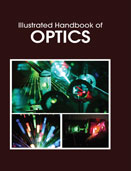Handbooks

Optics is the field of science and the area of economic activity encompassing the physical phenomena and technologies associated with the generation, transmission, manipulation, detection, and utilization of light. It extends on both sides of the visible part of the electromagnetic spectrum as far as the same concepts apply. This guide covers a very large domain and is experiencing indisputable growth. It has enabled the development of a considerable number of instruments, the optical component or methodology of which is often the essential part of portent systems.
Optics is descended from the ancient Greek science of mathematical perspective, in which the behavior of the rays of vision was discussed by deductive geometry. When it was realized that light was a physical, objective thing, Optics became the study of that thing, between the lamp and the eye, but not including the source or the receiver except as necessary to the argument. It studies facts like how light reflects off of objects, or the energy of other forms of electromagnetic waves and usually describes the behavior of visible, ultraviolet, and infrared light. Because light is an electromagnetic wave, other forms of electromagnetic radiation such as X-rays, microwaves, and radio waves exhibit similar properties.
Illustrated Handbook of Optics offers a complete, concise and practical introduction to optical phenomena and of instruments and technology based on them. Our modern day electronic devices are based on transistors and other semiconductor devices. Moore?s law has proved to be nearly accurate as we develop better and smaller circuits having more number of transistors per square inch. However, there will be a time maybe after two decades where we may not be able to make any further development with the integrated circuit based devices. The future computing devices, be it quantum computers or for that matter even simple photonic integrated circuits, have already given us a new perspective to the power and versatility of computation in the future. With the ever increasing demand for faster and more efficient computing, photonics seems to be a promising discipline. Metamaterials are artificial, precision-engineered materials which can exhibit peculiar properties not found in natural materials which makes them interesting. Metamaterials are predicted to be of great use particularly in defense applications to impart stealth and conceal units. The importance of light in material processing was understood after the development of photography. Since then laser-cutting of metallic blocks in the industry and various other processes were developed. Today, material processing using light has become highly sophisticated. The study of optics has huge applications to the technology on earth and is extremely helpful in many ways. In fact, without the study of optics, none of you would be reading any of this right now.
The Illustrated Handbook of Optics introduces readers to applied optics, covering elementary ray and wave optics, as well as lasers, holography, fibers, integrated optics and quantum noise. This Handbook is predominantly useful for students and researchers in the field of Physics and Engineering.